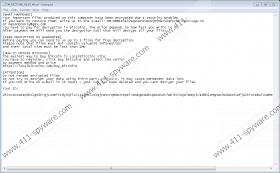Master Ransomware Removal Guide
Master Ransomware encrypts almost all data located on the computer it infects, except the files placed in directories titled as program files, program data, windows, $recycle.bin, nvidia, intel, and so on. Thus, we could say it mostly targets files created by the user, e.g. text or other documents, pictures, photos, videos, etc. In the note presented after this targeted data becomes enciphered, the malware’s developers suggest the victim can get a decryptor for an unspecified amount of Bitcoins. However, as much as you wish to get your files back, we would not advise you to deal with these hackers, because it is entirely possible you could end up being tricked. Another important thing to know about this malicious application is that it might damage Windows if the user decides to restart the computer. This is why our specialists advise you to erase the malicious program at once while using the instructions available at the end of the text.
It is believed Master Ransomware might be distributed through infected email attachments. Emails carrying such files could say it is important that the attachment is opened as soon as possible or it might provide no explanation at all and as a result raise the user’s curiosity. The threat’s source may look like an image, text document, invoice, etc. Therefore, less experienced users might open them without considering it could be dangerous. The next time we would recommend scanning such an attachment with a trustworthy antimalware tool before deciding to open it, especially if it comes from an unknown sender or you were not expecting to receive it.
If Master Ransomware is launched, there is still hope the system could be saved, but for that, the user would have to have a legitimate antimalware tool installed. Otherwise, the infection starts enciphering its targeted files without any delay. All encrypted files become marked by an additional .master extension, and the victim becomes unable to access them. Besides enciphering your private data, the malware may execute a few other commands, e.g. to make the computer delete all shadow copies, disable Windows Startup repair tool, and so on.
Our specialists say the malicious application may also have a command to erase or damage some of the Windows operating system’s files in order to prevent the computer from booting. We noticed it happening if the computer is restarted while the malware’s launcher is still running. Unfortunately, in such situation, the only way to boot the PC is to reinstall the operating system. For this reason, it is most advisable to eliminate the threat immediately if you do not want to damage the system. As for Master Ransomware’s displayed ransom note, we would advise you not to pay any attention to it because there are no guarantees the hackers will send the tool after you pay the ransom or will not ask to transfer even more money.
Upon the malware’s launch, it might create a Registry entry and scatter a lot of copies of !#_RESTORE_FILES_#!.inf (the infection’s ransom note). Our specialists who tested the threat did not notice it creating any other data. It would seem the malicious program runs right from the directory where its launcher was downloaded and opened. Since this file should continue to run, you will have to kill it with the Task Manager or else you might be unable to erase it. Then, it would be advisable to get rid of Master Ransomware’s created ransom notes and the Registry entry. Obviously, the removal might be not an easy task, so you should carefully follow the recommended deletion steps available below this text.
Remove Master Ransomware
- Tap Ctrl+Alt+Delete and launch Task Manager.
- Click on the Processes tab and find a suspicious process related to the malware.
- Select this process and click the End Task button.
- Close the Task Manager.
- Press Windows key+E to run File Explorer.
- Check the given locations:
%TEMP%
%USERPROFILE\Downloads
%USERPROFILE\Desktop - Look for the malware’s launcher, right-click it and press Delete.
- Exit the Explorer.
- Tap Windows key+R.
- Insert regedit and press OK.
- Go to the given location: HKCU\Software\Microsoft\Windows\CurrentVersion\Run
- Search for a value name named as DECRYPTINFO with the value data pointing to C:\Users\user\AppData\Roaming\!#_RESTORE_FILES_#!.inf
- Right-click the malicious value name and choose Delete.
- Close your Registry Editor.
- Locate all !#_RESTORE_FILES_#!.inf files and right-click all of them to Delete.
- Empty your Recycle bin.
Master Ransomware Screenshots:


